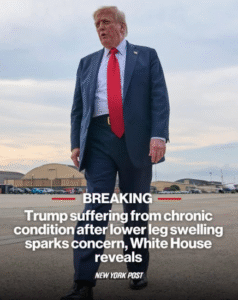Trump Suffering from Chronic Condition After Lower Leg Swelling Sparks Concern, White House Reveals
Former President Donald Trump is reportedly battling a chronic medical condition that has raised concern following visible swelling in his lower legs. According to recent White House disclosures, the 79-year-old political figure has been experiencing persistent symptoms that medical experts say are consistent with circulatory or vascular issues, sparking public attention and speculation.
Sources close to the matter indicated that Trump had been seen in recent weeks using extra support while walking and at times appeared to be in discomfort, prompting speculation among supporters and the press. Although the exact nature of the condition has not been formally confirmed, those familiar with the situation have suggested it may involve chronic venous insufficiency, a condition that impairs blood flow from the legs back to the heart and can result in swelling, fatigue, and pain.
A statement released by the White House physician clarified that Trump had undergone a full physical evaluation earlier this month. “Following recent swelling in the lower extremities, Mr. Trump was evaluated for several vascular and orthopedic conditions. He is currently receiving treatment and his prognosis remains positive,” the statement said. The physician emphasized that while the condition is chronic, it is being managed through non-invasive therapy, medication, and a monitored exercise plan.
Trump’s team has remained relatively quiet on the specifics of his health, maintaining that the former president continues to lead an active schedule and is “in fighting shape” as he gears up for potential campaign activities. A senior aide noted that the former president has “no intention of slowing down” and continues to participate in rallies and meetings regularly. Nevertheless, the aide did acknowledge that “health precautions are being taken.”
Medical professionals not directly involved in Trump’s care have speculated that the swelling could stem from several common chronic conditions in older adults, including lymphedema, deep vein thrombosis, or complications related to long-standing orthopedic injuries. Such conditions often require lifestyle modifications, ongoing monitoring, and, in some cases, compression garments or surgical procedures.
Observers have pointed to recent photos in which Trump appeared to be wearing more cushioned footwear and favoring one leg while walking. The visual clues, combined with limited public appearances over the past several weeks, have fueled widespread discussion online and among political analysts regarding his long-term fitness.
Health has long been a sensitive topic for Trump, who often portrayed himself as physically vigorous during his presidency. In the past, he has boasted about his strength, energy levels, and endurance, downplaying concerns even during moments of visible fatigue. Some of his critics have accused his team of minimizing or obscuring medical details, while his supporters have defended his resilience.
Former White House officials familiar with presidential health protocols emphasized the importance of transparency, especially when a political figure remains influential in national affairs. “Public figures have a responsibility to share essential health updates, especially if they intend to run for office or hold sway over policy decisions,” said Dr. Elaine Booker, a former presidential health advisor.
Despite the growing attention, Trump himself has not publicly commented on the matter, nor has he addressed the circulating images or medical theories. His last rally appearance included only a brief mention of “feeling great” and being “ready to lead again.” Supporters at the event did not appear concerned, cheering him on as he delivered his usual energetic speech.
It remains to be seen whether Trump’s medical condition will affect any future political plans. Analysts suggest that while chronic illness can be managed, it may require adjustments in campaign schedules, travel routines, and personal appearances—particularly as election season intensifies.
For now, the White House has assured the public that the condition is “under control” and that Trump continues to receive high-quality medical care. “There is no cause for immediate alarm,” said the physician’s note, “but appropriate measures are being taken to support his continued well-being.”
As speculation continues, many await further updates on his condition, hoping for transparency and clarity amid rising political stakes.


